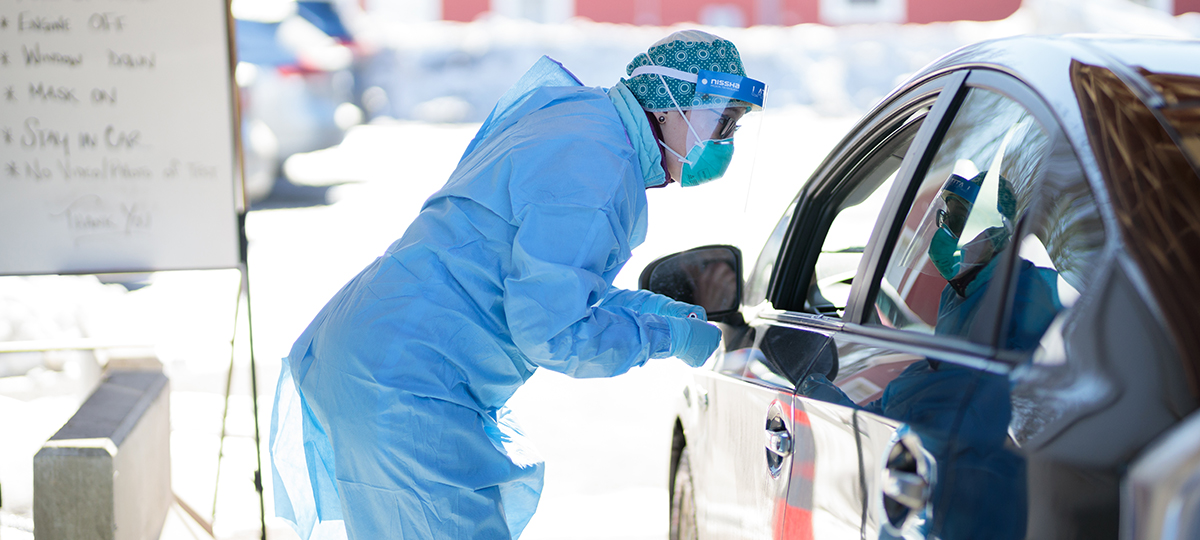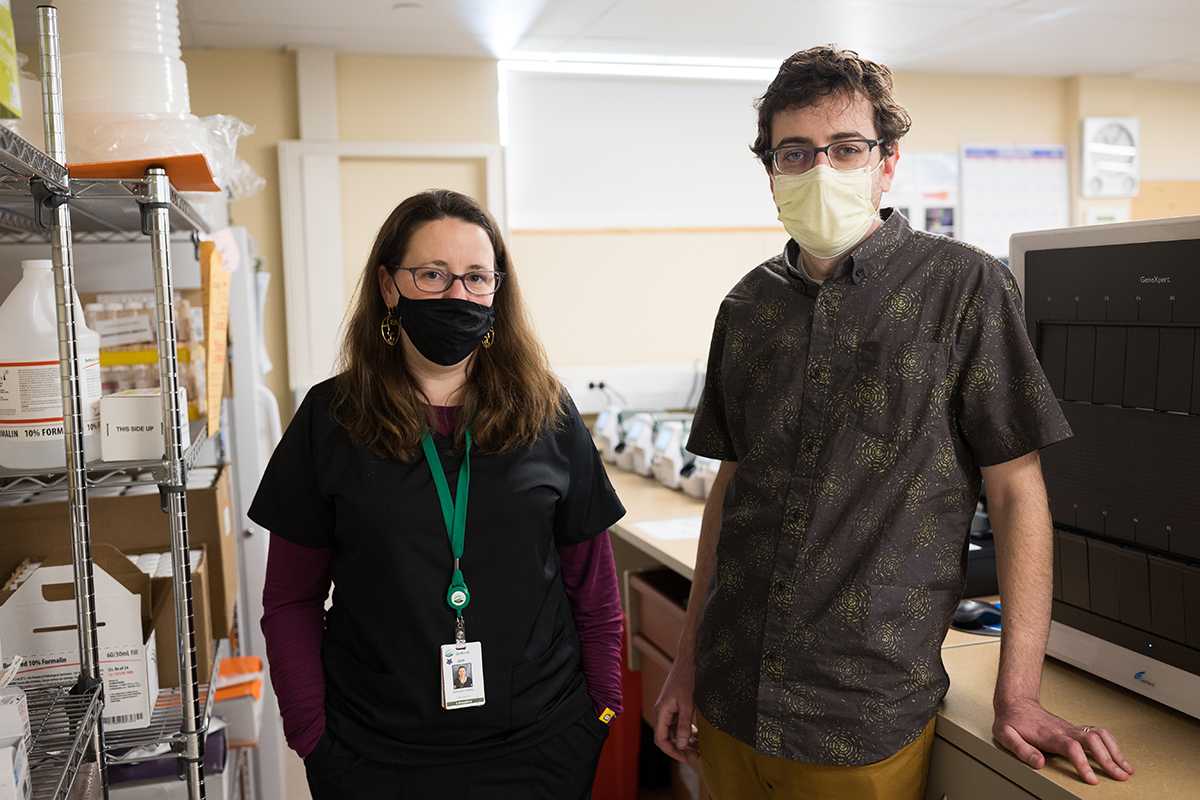

Staffer Jo Alexander works Gifford’s COVID-19 community testing drive-thru.
“Expanding the capacity, throughput, speed of returning results, analytic performance, and regional placement of diagnostic technologies is urgently needed and, if successful, will contribute importantly to the current national efforts to curb the COVID-19 pandemic …”
– New England Journal of Medicine
July 22, 2020
Testing is key in the fight against COVID-19, but shifts in direction from government officials, coupled with rapid changes and misunderstanding surrounding testing and availability, have created an at-times confusing landscape over the course of the pandemic. At Gifford, a team that includes medical providers, infection prevention, and a skilled and flexible laboratory staff worked collaboratively to ensure the success of a drive-thru community testing program.
At the core, education and straight talk, often in video messages to the community from Gifford leadership, helped to clear up confusion and answer frequently asked questions about testing and other aspects of Gifford’s COVID-19 response.
“One thing I didn’t anticipate was the shifting legislative and regulatory issues we’d face,” said Gifford Chief Medical Officer Dr. Joshua White. “The testing program is a great example. We looked at different countries around the world who had success. They did well when they tested a lot. This hasn’t been the paradigm in the United States, historically, and a lot of people struggled with that.”
“One week, we would be told that we were testing too much and putting a strain on resources, the next we’d be told that we need to do more testing, and the next we’d receive another contradictory message,” said White.
While they experienced frustrations at times, Gifford senior leadership and Incident Command remained focused on developing protocols and strategies that implemented recommendations from the World Health Organization (WHO) and Centers for Disease Control and Prevention (CDC). These recommendations capitalized on experiences in Singapore and Hong Kong.
“Our strategies included evidence-based PPE protocols to protect staff, social distancing, frequent handwashing, and a strong community testing program,” said Senior Director of Quality/Risk Management Monica Boyd. “In the beginning, supplies were really limited but as supplies became more readily available, we expanded from testing a handful of people a day to a target of 40-50 per day, Monday through Friday. During weeks through peak COVID, we were testing nearly 100 community members per day.”
“Because COVID has a wide range in terms of severity of illness, we included and encouraged asymptomatic as well as ill individuals for testing,” said Boyd, who in her role oversees quality and risk management, infection prevention, medical staff credentialing, regulatory readiness, and compliance. “Accessible testing allows for early identification of COVID cases and minimizes the likelihood of outbreaks.”
Gifford’s testing program also includes a contact-tracing component led by Boyd and Kate Walker, Gifford’s Infection Prevention specialist.
“We call each person who has tested positive to ask about their symptoms, the people with whom they’ve had contact, and arrange any subsequent testing needed,” she said. “We felt this type of testing program was a key factor in assisting businesses and schools to remain open over the course of the pandemic.”
The community testing program owes its success in large part to partnerships and collaborative work among staff across departments, including Patient Registration, the Emergency Department, Care Management, Rehabilitation Services—they all helped staff the COVID testing program—and the Gifford Lab, who processed specimens and received countless phone calls.
Supply challenges and quick turnarounds have proven the most challenging aspects of maintaining the program, but, Boyd said, “Materials Management has been amazing at keeping us stocked with what we need. And our laboratory has been phenomenal in managing availability of supplies and turnaround times over the course of COVID.”
Lab Manager Matthew Clayton oversees a team of about 20 staff—lab technologists, technicians and assistants who keep the lab running 24 hours a day, seven days a week, 365 days a year.
“I wouldn’t want to do this anywhere else,” said Clayton of being a part of Gifford’s COVID response. “I feel like this experience, the pandemic, has shown me even more so why I love Gifford, the people here, the community here. We work on these tight teams and make tough decisions.”
Clayton has relied heavily on his team, whose role has changed significantly over the course of the year.

Lab Technician Jennifer Celley and Lab Manager Matthew Clayton.
“When we first saw this coming, we focused on gathering any available resources for the lab,” he said. “We looked at where can we send testing, as at the time there was no way we could run in house. We asked ourselves, what reference labs can we work with to make sure we get results back in a timely manner?”
Then, “shift from summer to fall, and our role changed as we started bringing more instrumentation into our lab. Now we’re able to support our testing program in house, running some tests in our lab and continuing to work with reference labs.”
The lab at University of Vermont Medical Center is a key partner.
“UVM gives us really fast results and is a huge player,” said Clayton, who’s been at Gifford for seven years. “We work closely with them, looking at what our resources are and trying to utilize them the best we can, determining when we send out testing or perform here.”
All of this work adds a lot to what the Gifford Lab does in a given day. To provide context, in previous years, “gonorrhea/chlamydia probes represented the highest lab sendout in any given year, at about 2,000,” Clayton explained. “This year, we’ve probably sent out 12,000 for COVID. You can see in those numbers alone how much more we’re sending out.”
Despite the increased workload, lab techs and assistants are proud to do their part.
“We are happy to be a part of the COVID testing program, helping to keep everyone safe,” Clayton said. “Some of it was difficult, initially, when plans were first coming together and when there was general fear in the community and within the hospital. People were working extra. … But, as time progressed, our dedicated staff found our rhythm.”
That staff includes a mix of full-time and per-diem employees who work three different shifts. Technicians have specialized certification in chemistry, hematology, blood banking, and microbiology. Assistants perform blood draws and do administrative work. Over the course of the pandemic the team has reorganized and strengthened their roles, and Clayton is quick to praise them.
“The whole lab has been phenomenal,” he said, specifically citing the work of colleague Jennifer Celley. “Jennifer is a lab tech with a specialized role. She has been a huge help through all of this.”
Together they work with Boyd’s Quality/Infection Prevention team to prioritize testing and inform contact tracing; the COVID specimen-collection team, comprised of nurses and Patient Registration; the Vermont Department of Health for reporting; and, in addition to UVM, other labs within Vermont.
These partnerships, Clayton said, represent the silver lining of the pandemic.
“We all work closely together. It’s been a good thing—strengthening ties with other labs within Vermont, and with other departments at Gifford. The pandemic has reminded me of the reasons why I appreciate Gifford and the people I work with so much, even more so now.”
###

